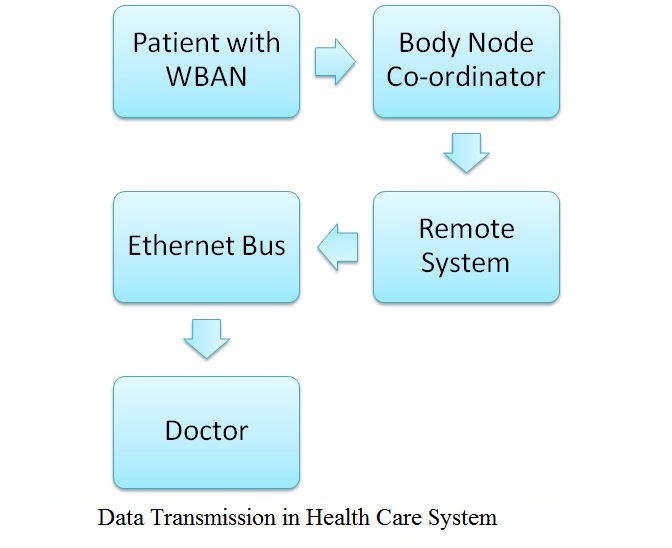Artificial Intelligence Body Area Network (WBAN) Help in OMNeT++
We offer specialized Artificial Intelligence Body Area Network (WBAN) Help in OMNeT++ for students and researchers. Our services focus on cutting-edge projects using AI for healthcare networks with wireless sensors that can monitor a patient's vital signs.
What is Body Area Network?
A Body Area Network, also called Wireless Body Area Network (WBAN), is easily portable and can be implemented on the human body. It is widely used in medical applications where vital signs such as sugar level and blood pressure can be monitored. If WBAN is implanted in a particular area, it can also be used for security and military purposes, making it a versatile choice for healthcare, biomedical, and defense domains. With our Artificial Intelligence Body Area Network (WBAN) Help in OMNeT++, researchers can simulate and analyze these applications effectively.
There are two types of WBAN communication:
1. Extra-body communication
2. Intra-body communication
Extra-body Communication
In Extra-body communication, communication happens between the sensor nodes placed on the body and sensor nodes outside the body. For example, in military WBANs, sensors monitor a soldier’s condition and send data to the command center. Similarly, in patient monitoring systems, WBAN sensors transmit data to doctors for real-time diagnosis. These are examples of Artificial Intelligence Body Area Network (WBAN) Help in OMNeT++, ensuring secure and reliable communication between body sensors and external systems.
Intra-body Communication
In Intra-body communication, the communication happens between sensor nodes implanted inside the human body. This type is often used for advanced biomedical and healthcare solutions requiring direct internal monitoring.
WBAN in OMNeT++
WBAN can be implemented using OMNeT++, which is an object-oriented modular network simulation framework. We provide UG, PG, and Ph.D. project support in simulating body area network projects. Our Artificial Intelligence Body Area Network (WBAN) Help in OMNeT++ ensures accurate patient monitoring simulations with real-time data analysis and AI-driven solutions.

The figure above shows a WBAN network for patient monitoring, where sensors monitor patient parameters such as heart rate, BP, and sugar levels. A Body Node Coordinator (BNC) collects the data and transmits it securely to the doctor for further diagnosis. This is one of the core applications covered in our Artificial Intelligence Body Area Network (WBAN) Help in OMNeT++.
We support UG/PG students and Ph.D. scholars to successfully carry out their project work. Our team guides them in the correct path to simulate, analyze, and publish results for their Artificial Intelligence Body Area Network (WBAN) Help in OMNeT++ projects.
Article
The Best Choice
Services
Coding Implementation Services
OMNeT++ Coding Support
We offer a comprehensive OMNeT++ simulation tool that allows you to develop a wide range of OMNeT++ based networking Projects.
Read MoreNs3 Coding Support
Our team of experts develops custom NS-3 simulations and implements innovative protocols to address your unique networking challenges.cbg
Read MoreMATLAB Coding Support
Empower your research with our expert MATLAB coding assistance for research scholars
Read MorePython Coding Support
We provide comprehensive Python coding support for research scholars, from project conception to implementation and analysis
Read MoreCooja Contiki
We facilitate research progress by offering Cooja Contiki coding support for research scholars
Read MoreSumo Coding Support
We partner with research scholars by providing tailored Sumo coding support
Read MoreLatest Blog
Latest Articles From Our Blog Post

Latest Research and Thesis Topics in VANET
Vehicular Ad Hoc Networks (VANETs) represent a cutting-edge technology with the potential to revolutionize transportation systems.
Read More
PhD Guidance in Vehicular Ad Hoc Networks (VANET)
Vehicular Ad Hoc Networks (VANETs) are rapidly evolving, offering a transformative vision for the future of transportation.
Read MoreGet In Touch
Contact us for Body Area Network (WBAN) Projects in OMNeT++ with full implementation and research support. We provide simulation guidance for students and PhD scholars using OMNeT++ for healthcare, IoT, and WBAN applications.
No-35, South Usman Road,Chennai,India
phdacademy74@gmail.com
+91 8870457435
Popular Links
© PhD Academy. All Rights Reserved.